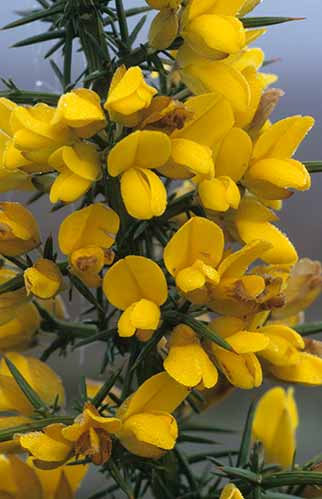Gorse (Ulex europaeus)
When: All year round
How many:
Widespread and very often abundant

Gorse, or furze as it is locally known, is a perennial evergreen. Gorse is common and widespread on New Forest heaths, second only in abundance to the heathers, and can also be found along inclosure rides, particularly in places originally planted on heathland.
A plant of well-drained soils, gorse has been found to be a good indicator of ground that has been disturbed in the relatively recent past by, for example, sand or gravel workings, or First or Second World War military activity.
Gorse's richly scented, bright-yellow flowers are most prominent in late winter and early spring as the heaths throw off their dull, dark, winter mantle and take-on a glorious, golden glow. Gorse flowers, though, at least in small quantities, can be seen in every month of the year, giving rise to the old saying ‘when Gorse is not in bloom, kissing is out of fashion.’ They should not, however, be confused with those of the low-growing, closely related dwarf gorse that appear in late-summer.
Bees are important pollinators of gorse, and, as befits a member of the pea family, seeds are produced in dark-coloured, elongated pods that when ripe, burst noisily open on hot summer days, scattering far and wide their precious cargo.
Occasionally, gorse bushes may be found draped in a mass of tangled red threads – these are stems of common dodder, a plant that in the New Forest is parasitic on gorse and the heathers.
Large numbers of insects shelter within the confines of gorse, including multitudes of spiders whose dew-laden webs gloriously light-up misty, early heathland mornings. Indeed, Dartford warblers habitually navigate a way through gorse's prickly maze of branches, searching for the spiders, and other insect prey, whilst stonechats use the upper reaches as lofty perches from which to noisily chak territorial defiance.
Gorse is also one of the main caterpillar food-plants of the dainty, green hairstreak butterfly, which lays its superbly camouflaged, pale green, flattened sphere-shaped eggs in the tender leaf tips or flower buds.
Often growing in almost impenetrable clumps, gorse provides ideal shelter from the weather for New Forest ponies, and despite its rigid, barbed spikes, is an important source of food for the stock, especially in late-winter when alternatives are in short supply.
In fact, incongruously bearded animals were at one time widespread in the New Forest, the outgrowths of hair evolved to combat the spikes, whilst in earlier times, when gorse was deliberately sown or planted, John Evelyn (1620-1706) wrote: ‘no provender…makes horses so hardy as the young tops of these Furzes.’
New Forest keeper Gilbert Smith remembered in the early 1900s carrying back to the homestead gorse for the family horse: ‘Another chore was to help collect young gorse from Latchmore which was part of Betsy’s diet after being put through the chaff cutter. The young gorse shoots were cut off by Dad and we would have little forked sticks to pick it up and put it in rows; it was far too prickly to handle. Dad would then tread the rows with his hob-nailed boots which would take off a lot of the spikes before loading it into the cart.’
Nowadays, rotational heathland burning removes the stems of old, woody gorse bushes - they can live for 30 years, or more – and encourages regeneration of fresh, new shoots more suitable for the stock.
Gorse in days-gone-by also substantially contributed to the cottage economy in a number of other ways – it was used, for example, as a fuel for the fire and as a thatching material.
References:
The Flora of Hampshire: Anne Brewis, Paul Bowman and Francis Rose
The New Forest – A Natural History: Colin R. Tubbs
Collins New Generation Guide - Wild Flowers of Britain and Northern Europe: Alastair Fitter
The Encyclopedia of British Wild Flowers: John Akeroyd
The Hamlyn Guide to Butterflies of the British Isles: J.A. Thomas
Gilbert Smith, New Forest Recollections
More links
Other related links
Search this site

Sadly, 58 animals were killed - 35 ponies, 13 cows, 8 donkeys and 2 sheep, whilst a further 32 were injured - 3 pigs, 9 donkeys, 11 cows and 9 ponies.
(Forty-three accidents occurred in daylight, 15 at twilight and 101 in the dark. Twenty-seven accidents were not reported by the driver involved).
Here's just one horrific example - Three donkeys killed in collision with van at notorious New Forest blackspot (Advertiser and Times)

